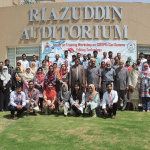Air pollution is an invisible killer, leading to higher health and environmental risks. According to World Health Organization (WHO), unsafe levels of air quality exacerbating the respiratory and cardiovascular complications cause 7 million premature deaths per year.
The major sources of air pollution are motor vehicles, forest fires, industrial facilities, and household combustion devices. The major risk factors from these sources are carbon dioxide, particulate matter, carbon monoxide, ozone, nitrogen dioxide, and sulfur dioxide. High air pollution may result in cancer, bronchitis, asthma, and other respiratory problems.
Therefore, air quality needs to be a national issue, as most people are unaware of the poison, they breathe in.
Owing to the fact that air pollution has now become a global threat, millions of dollars are invested to develop innovative technologies to monitor and mitigate air pollution.
Till-date mother nature is the best candidate. We all are well aware that planting trees is a long-familiar way to reduce air pollution but at the same time it is a laborious and time-consuming phenomenon that require an ample area of land which is not always a viable option.
So, to find a suitable alternative one should first understand the entirety of a problem, aiming to devise a low-cost, more reliable and eco-friendly approach.
We have always taken Moss for granted, since the only thing we know about them is their ability to destroy rocks and stain stone statues, for long neglecting their extraordinary properties.
Since the late 1960s scientists have exploited moss as a biological indicator of air pollution, past studies have shown that they can complement the existing air quality monitoring tools that are extremely costly and cannot be installed anywhere.
Moss has the natural ability to take up water, nutrient, and fine dust particles from the environment like a sponge. These incredible properties of mosses have gained the attention of researchers towards their diverse industrial applications.
In April 2012 the European Union (EU)-funded research project MOSSCLONE led by biologist Prof. Dr. Ralf Reski started a system. They employed the use of peat moss Sphagnum palustre, for monitoring air pollution. The results of this research were astonishing, as the researchers found high levels of multiple top priority metals such as arsenic, cadmium, chromium, cobalt, nickel, and lead in moss. This method is proved to be a cheap and very effective approach in monitoring small-scale pollution sources.
In the ongoing struggle to tackle air pollution, a mossy “vertical plant wall” with the pollution absorbing potential was launched in London in June 2018. It was designed by German startup Green City Solution. This research was conducted in response to the high mortality rate observed in London due to respiratory, cardiovascular, and other diseases associated with pollution.
The City tree is a combination of mosses and Smart loT technology which not only generates a cooling effect on the surrounding area–ideal to combat urban heat but also possess the ability to remove pollutants from the air such as particulate matter, nitrogen dioxide, and other greenhouse gases, etc.

The City tree has the capacity to reduce pollutants up to 30%. It holds the potential of 275 urban trees to take out a maximum of 240 tons of carbon dioxide per annum. It only takes 1% of the space as compared to the actual trees which take up enormous space and time for growth. Apart from it, these “biotech filters” along with sensor technology are mobile in nature that can be installed anywhere in the cities to combat unsafe levels of air quality.
The City tree has been successfully launched in many cities around the world, including Oslo, Paris, Brussels, and Hong Kong. In a short period, the city tree has become an effective way to clean the environment.
Keeping in view the US air quality index “Lahore ranks the most polluted city in the world”. According to the Global Alliance on Health and Pollution, an estimated 128,000 people die annually from air pollution-related illnesses across Pakistan.
As the COVID-19 pandemic arises, researchers’ comprehensive studies indicate a clear correlation between fine dust pollution and high mortality rates of COVID-19 –co-factor behind an average 15% of COVID-19 deaths worldwide. It requires extensive media coverage to generate awareness against this alarming situation of air pollution.
The environmental issues in Pakistan needs more attention from government, city corporations and each one of us, whereby installing moss-based natural and low-cost screening technology in our homes, offices and other localities might be a savior in times of crises.

Even the least wealthy countries can do such a thing that wealthier countries could do. Hopefully, this idea can save the mega-cities of Pakistan like Lahore and Karachi from creeping air pollution in a much cheaper and effective way.
![]()

A postgraduate student at NUST. As a researcher aiming to obtain a challenging position where each day brings something new that desires creativity to solve it.




